As I write this, I'm waiting for our students to return from their weXplore, a five-day excursion that takes students beyond their host city for immersive cultural experiences. For the past two months, we as a school have called Maun, Botswana, our home. It's a small town on the edge of the Okavango Delta and, for many travelers, a doorway into Africa. But Maun is only one perspective, and it...
Read MoreDuring the Winter Term of THINK Global School’s 2014-15 school year, the 9th and 10th grade students spent 34 days exploring Costa Rica. As they made their way across this Central American paradise, they spent time living with local families; studied primates and dolphins; immersed themselves within rainforests; whitewater rafted down rivers; and studied marine biology on pristine beaches. Head of School Jamie Steckart joined Team Omega for a ten-day stretch of the journey. The following blog details his observations.
During the course of my travels, I am always intrigued by end-of-the-road destinations. I’m not talking about the type of dead ends you accidentally come across in a city. I’m talking about the places you actually seek out. They require effort and a level of discomfort, trepidation, and adventure to find. Once there, if you’re mindful, magical things can happen. This two-part series highlights two places at opposite ends of Costa Rica: two end-of-the-road destinations and two magical experiences.
Part 1: Army Trucks
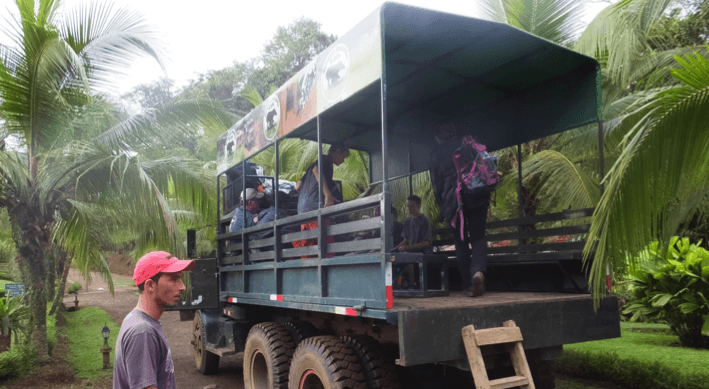
Our travels included many forms of transportation
We said goodbye to Israel, our friend and guide from El Zota biological field station, and boarded the army green two and a half-ton truck that would take us to a road accessible by minibus. We had spent the last three days studying primates in a rainforest a few miles south of the Nicaraguan border.
During those three days, we were successful in spotting three of the four monkey species indigenous to Costa Rica: the mantled howler, Geoffroy’s spider monkey, and the white-headed capuchin. At night we searched for snakes, frogs, and lizards under the pale glow of the moon.
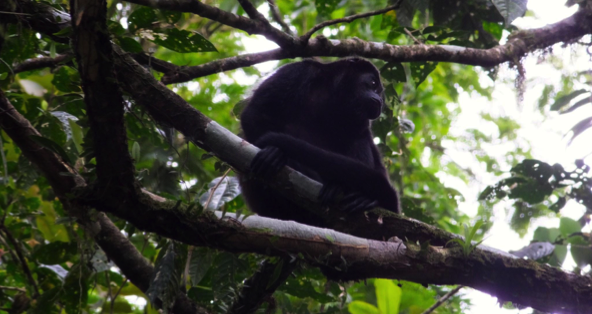
A mantled howler monkey camps out in a tree
While we explored the rainforest, I was given a tour of the K-12 schooling common to children of that area. Just like in America, school quality is dependent upon the wealth of the local community. I was told that the government funds the teachers and provides land and a “building” for instruction. They also provide satellite internet access (I’ll talk about that in a minute). Anything extra must come from the generosity of the community. Israel told me that the average farmer in this part of the country subsists on $500 a month.
He took me in his SUV to a small border town where we visited a K-6 school. To give you an idea of the quality of life for the town’s residents, most survived on fish they caught in a nearby river. The school’s gates were locked, and we were told by a neighbor that the school board president had the keys. We drove to the end of the road and stopped at a small store to get the phone number for the president. As we dialed we could see her across the river running for her phone. She said she would come on over in a few minutes. As we watched her struggle to start the outboard engine of the boat, a child of no more than six came down to the river and got the boat running. Israel told me it was common for six-year-olds to captain the boats and take 5-10 youngsters to the school. In total, 22 children attend the school and next year they are excited to begin taking in kindergarten students. High school students have to travel three hours round-trip to attend.
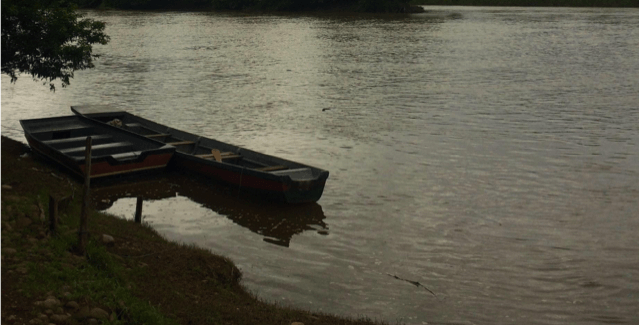
Getting to and from school is no easy task
Three years ago Israel was approached by the school for help. The economy was depressed and for some reason the fishing could not sustain the village. He drove out to the school and found that the entire community needed help just getting enough to eat. The first year they focused on food, although they had the following problems: no running water, no toilets, and the teacher was forced to live in a shack by the river.
We drove up the hill to the school, and I admired that it was located at a gorgeous bend in the river. As we arrived, we were met by the school’s president, who was in the process of opening the sturdy, locked gates.
As we made our way around the campus, Israel was proud of the fact that the school now had tile floors, a well and running water, toilets, a new roof, a small room for the teacher, and a place to cook lunch — all completed by volunteers and donations. Three years ago, the government put in the internet but failed to provide the basic necessities to thrive.
How do we reconcile the vast disparity between the education THINK Global School provides and the education that millions of children receive worldwide? We began with a simple plan. Leaving El Zota that day, the first step was to bring tech resources to some of the schools in the area and allow them to access the government-installed Internet. Israel said he had college interns that could help teach tech skills if provided with the appropriate hardware.
To be honest, at the time I had no grandiose plans. I shot from the hip to fill a need.
Reflecting on the experience, I think in the back of my mind I knew I was on to something. Back in 2010 I watched a great TED Talk, The Child Driven Education, by Sugata Mitra. It must have been percolating in the back of my mind and surfaced to grow, now that it was given the right environmental conditions.
We were going to create our own version of “The Hole in the Wall Project.” Sugata had done it in India, and we could partner with Israel to do it here in Costa Rica. The hardest part of connecting to the Internet was already in place. As Sugata points out, creating equal access to the Internet can drive remarkable changes. I watched and was inspired by his ideas of how technology could decrease the remoteness of people. By leveraging technology, we could connect this small village to the greater world. Once this step was completed, we could continue the dialog with the children and THINK Global School students.
Part 2: Ocean Skiffs
Bus drivers joke that the roads in Costa Rica are the best because not only do you get to your destination, but you also get a free massage. Army trucks excel at jarring everything loose in your body. Finally, we boarded a bus heading to another end-of-the-road destination. Seven hours later we found ourselves near the Panamanian border in Manzilla.
Manzilla is a small town on the Caribbean side of Costa Rica. It is a blend of Jamaican, Spanish, and French influence. North of the town is the port of Limón. This is the center of business for Dole and Chiquita in Costa Rica.
Huge container ships arrive and depart daily bringing piñas (pineapples) and plátanos (bananas) to our tables. Monocultures of either pineapple or banana plantations exist as far as the eye can see. Heavily sprayed with chemicals, the American fruit juggernauts rely on Nicaraguan laborers to perform the grueling task of harvesting the crop.
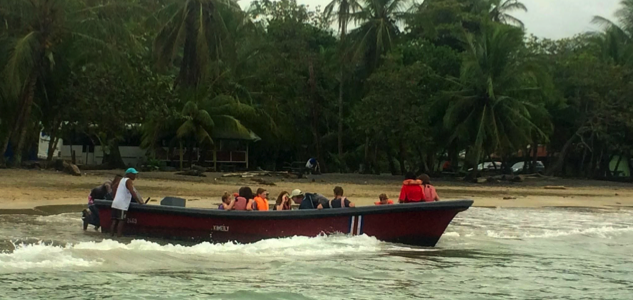
Setting off for Punta Mona
As the driver dropped our luggage from the roof of the bus, we looked to the ocean for our ride. Bobbing in the surf were two thirty-foot skiffs, six foot at the beam and powered by 100 horsepower Honda outboards. We loaded the luggage, strapped on lifejackets, and set out to sea. Our destination was Punta Mona.
From their webpage, “Punta Mona is an 85 acre off the grid, family owned environmental education center, botanical collection, permaculture farm and eco-lodge, dedicated to sustainable ways of living.”
Stephen Brooks, founder and owner, met us at the beach. He is a gregarious man with a warm smile and big heart. I was immediately drawn to him after finding out he attended my alma mater, The University of Wisconsin-Madison, from 1991-1994. I graduated in 1991, so there was the possibility that he and I passed each other on the campus, fated to see each other again in 2015. We circled up and met his wife Sara, a herbalist and co-director.
Everything about Punta Mona is intentional, as the staff try to mimic the best processes of nature. The vegetation surrounding the buildings is a living grocery store. From breadfruit to jackfruit, from papaya to bananas, from basil to lemongrass — all growing in harmony with nature. Devoid of toxins and thriving on advanced techniques of permaculture, this oasis painted a picture of what intentional communities could be.
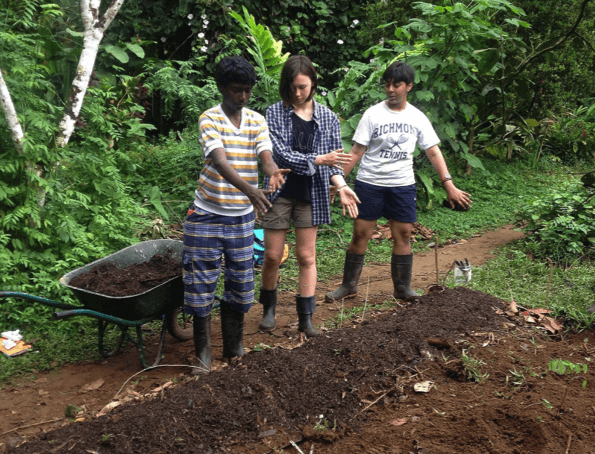
Victor, Erica, and Utkarsha work in the garden
Our gardening workshop with Alan from Mexico and Jam from Israel began with an in-depth lesson in soil quality. That day we got a crash course in hugelkultur. After digging a 24-inch trench, we began building layers of essential ingredients: rotting trees and fungus, freshly-cut logs, banana plants, forest duff, and chicken droppings — all topped with the topsoil we dug out at the beginning. Jam assured us these concepts could be applied to almost every region on the planet, and if done properly the planting would not need the addition of fertilizers.
To be honest, I could never live at Punta Mona, for I am a creature of the North. Hot, humid, and sticky environments I can tolerate for about the length of a Wisconsin summer. Yet, what I learned that day I could apply to my own community of Cornucopia, Wisconsin. Corny (which is what the locals call it) sits on the southern shore of Lake Superior and is home to the Apostle Islands. Last winter 80% of Lake Superior froze, giving foot access to the ice caves of the Apostles for the first time in five years. National Geographic sent a team there to document the event. Cornucopia is home to around 300 permanent residents, but that winter over 25,000 people came to see my end-of-the-road destination.
End-of-the-road destinations can provide a magical moment. You see, on my 10-acre forest land, I have all the ingredients to build a sustainable community. Learning is deep and lasting when you see a concept and can apply it to your own world. Our workshop ended with the students taking what they learned and partnering with a local school to build a sustainable garden.
The point wasn’t to drop everything and move on down south, although some people do that. For me, enlightenment came at the end of this two-day workshop. I thank Stephen and Sara for igniting the spark.
As member of the TGS community we frequently dip in and out of end-of-the-road destinations. We linger, we observe, we learn, but in the end, we leave. Although I still have some time left in Costa Rica, the rainforest has revitalized my hope for a better future and has given me some paths to venture on the road to a better world.
-Jamie Steckart, Head of School
